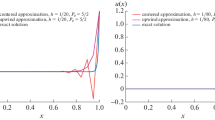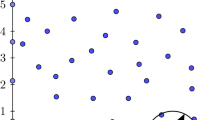Abstract
In this study, a novel upwind local backward substitution method (upwind-BSM) is developed for the simulation of two-dimensional convection-dominated diffusion problems. The high-order Pascal polynomial expansion method with a characteristic length factor is adopted to approximate the known boundary condition for transforming the original problem into a problem with a homogeneous boundary condition. Then the transformed problem is solved by the radial basis function-finite difference method, which generates a sparse interpolation matrix to improve the computation efficiency and avoid the ill-conditioned problem of the traditional global backward substitution method. A partial upwind point-taking scheme is introduced to eliminate the numerical oscillation resulting from the convection term in the governing equation. Several numerical examples are considered to illustrate the accuracy and efficiency of the newly proposed method. The results demonstrate that the proposed local collocation method is an accurate, efficient, and oscillation-free method for the two-dimensional convection-dominated diffusion problems.







Similar content being viewed by others
Data availability
No data was used for the research described in the article.
References
Tseng AA (1984) A generalized finite difference scheme for convection-dominated metal-forming problems. Int J Numer Methods Eng 20(10):1885–1900
Christie I (1985) Upwind compact finite difference schemes. J Comput Phys 59(3):353–368
Shyy W, Thakur S, Wright J (1992) Second-order upwind and central difference schemes for recirculatingflow computation. AIAA J 30(4):923–932
Chou CK, Wu CT, Shen LH, Young DL (2023) The application of upwind meshless approximation finite volume method to the convection dominated problems on the unstructured and deformed meshes. Eng Anal Bound Elem 155:717–737
Wang Y, Li Y, Meng X (2024) An upwind finite volume element method on a Shishkin mesh for singularly perturbed convection–diffusion problems. J Comput Appl Math 438:115493
Qian L, Feng X, He Y (2012) The characteristic finite difference streamline diffusion method for convection-dominated diffusion problems. Appl Math Model 36(2):561–572
Valseth E, Romkes A (2020) Goal-oriented error estimation for the automatic variationally stable fe method for convection-dominated diffusion problems. Comput Math Appl 80(12):3027–3043
He M, Sun P, Wang C, Huang Z (2015) A two-grid combined finite element-upwind finite volume method for a nonlinear convection-dominated diffusion reaction equation. J Comput Appl Math 288:223–232
Kansa EJ (1990) Multiquadrics—a scattered data approximation scheme with applications to computational fluid-dynamics—I surface approximations and partial derivative estimates. Comput Math Appl 19(8):127–145
Kansa EJ (1990) Multiquadrics—a scattered data approximation scheme with applications to computational fluid-dynamics—II solutions to parabolic, hyperbolic and elliptic partial differential equations. Comput Math Appl 19(8):147–161
Wu Z (1995) Compactly supported positive definite radial functions. Adv Comput Math 4:283–292
Wendland H (1995) Piecewise polynomial, positive definite and compactly supported radial functions of minimal degree. Adv Comput Math 4:389–396
Li J, Hon YC (2004) Domain decomposition for radial basis meshless methods. Numer Methods Partial Differ Equ 20(3):450–462
Tolstykh AI, Shirobokov DA (2003) On using radial basis functions in a “finite difference mode’’ with applications to elasticity problems. Comput Mech 33(1):68–79
Tolstykh AI, Shirobokov DA (2005) Using radial basis functions in a “finite difference mode’’. CMES: Comput Model Eng Sci 7(2):207–222
Oruç Ö (2021) A local radial basis function-finite difference (rbf-fd) method for solving 1d and 2d coupled Schrödinger–Boussinesq (sbq) equations. Eng Anal Bound Elem 129:55–66
Oruç Ö (2022) A strong-form local meshless approach based on radial basis function-finite difference (rbf-fd) method for solving multi-dimensional coupled damped Schrödinger system appearing in Bose–Einstein condensates. Commun Nonlinear Sci Numer Simul 104:106042
Adil N, **ao X, Feng X, He Y (2020) Numerical simulation of the convection–diffusion PDEs on a sphere with RBF-FD and RBF-GR methods. Int J Comput Methods 18:12
Londoñ MA, Giraldo R, Rodríguez-Cortés F (2023) An RBF-FD method for the time-fractional advection–dispersion equation with nonlinear source term. Eng Anal Bound Elem 151:565–574
Abbaszadeh M, Dehghan M (2021) Meshless upwind local radial basis function-finite difference technique to simulate the time-fractional distributed-order advection–diffusion equation. Eng Comput 37:873–889
Siraj-ul-Islam, Vertnik R, Šarler B (2013) Local radial basis function collocation method along with explicit time step** for hyperbolic partial differential equations. Appl Numer Math 67:136–151. NUMAN 2010
Golbabai A, Kalarestaghi N (2019) Analysis on the upwind local radial basis functions method to solve convection dominated problems and it’s application for MHD flow. Eng Anal Bound Elem 100:59–67 (Improved Localized and Hybrid Meshless Methods - Part 1)
Javed A, Baig A, Djidjeli K, Shahzad A, Hameed A (2021) Upwind skewed radial basis functions (USRBF) for solution of highly convective problems over meshfree nodes. Eng Comput 37:04
Reutskiy SY (2016) The backward substitution method for multipoint problems with linear Volterra–Fredholm integro-differential equations of the neutral type. J Comput Appl Math 296:724–738
Lin J, Reutskiy SY, Lu J (2018) A novel meshless method for fully nonlinear advection–diffusion–reaction problems to model transfer in anisotropic media. Appl Math Comput 339:459–476
Lin J, Reutskiy SY (2018) An accurate meshless formulation for the simulation of linear and fully nonlinear advection diffusion reaction problems. Adv Eng Softw 126:127–146
Reutskiy S, Lin J (2020) A RBF-based technique for 3d convection–diffusion–reaction problems in an anisotropic inhomogeneous medium. Comput Math Appl 79(6):1875–1888
Hong Y, Lin J, Chen W (2018) A typical backward substitution method for the simulation of Helmholtz problems in arbitrary 2d domains. Eng Anal Bound Elem 93:167–176
Lin J, Reutskiy S, Zhang Y, Sun Y, Lu J (2023) The novel analytical-numerical method for multi-dimensional multi-term time-fractional equations with general boundary conditions. Mathematics 11(4):929
Lin J, Bai J, Reutskiy S, Lu J (2023) A novel RBF-based meshless method for solving time-fractional transport equations in 2d and 3d arbitrary domains. Eng Comput 39(3):1905–1922
Safari F (2023) An accurate RBF-based meshless technique for the inverse multi-term time-fractional integro-differential equation. Eng Anal Bound Elem 153:116–125
Safari F, **g L, Lu J, Chen W (2022) A meshless method to solve the variable-order fractional diffusion problems with fourth-order derivative term. Eng Anal Bound Elem 143:677–686
Lin J, Chen F, Zhang Y, Lu J (2019) An accurate meshless collocation technique for solving two-dimensional hyperbolic telegraph equations in arbitrary domains. Eng Anal Bound Elem 108:372–384
Zhang Y, Lin J, Reutskiy S, Sun H, Feng W (2020) The improved backward substitution method for the simulation of time-dependent nonlinear coupled burgers’ equations. Results Phys 18:103231
Lin J, Zhang Y, Reutskiy S, Feng W (2021) A novel meshless space-time backward substitution method and its application to nonhomogeneous advection-diffusion problems. Appl Math Comput 398:125964
Sun HG, Xu Y, Lin J, Zhang Y (2021) A space-time backward substitution method for three-dimensional advection–diffusion equations. Comput Math Appl 97:77–85
Yue X, Wang F, Hua Q, Qiu X-Y (2019) A novel space-time meshless method for nonhomogeneous convection–diffusion equations with variable coefficients. Appl Math Lett 92:144–150
Zhang Y, Rabczuk T, Lu J, Lin S, Lin J (2022) Space-time backward substitution method for nonlinear transient heat conduction problems in functionally graded materials. Comput Math Appl 124:98–110
Zhang Y, Lin J, Reutskiy S (2023) A novel gaussian-cubic-based backward substitution method using symmetric variable shape parameter. Eng Anal Bound Elem 155:1069–1081
Zhang Y, Lin J, Reutskiy S, Rabczuk T, Lu J (2023) A Gaussian–cubic backward substitution method for the four-order pure stream function formulation of two-dimensional incompressible viscous flows. Eng Comput. https://doi.org/10.1007/s00366-023-01896-7
Abbaszadeh M, Dehghan M (2020) An upwind local radial basis functions-differential quadrature (RBFs-DQ) technique to simulate some models arising in water sciences. Ocean Eng 197:106844
Chan YL, Shen LH, Wu CT, Young DL (2014) A novel upwind-based local radial basis function differential quadrature method for convection-dominated flows. Comput Fluids 89:157–166
Dehghan M, Abbaszadeh M (2018) An upwind local radial basis functions-differential quadrature (RBF-DQ) method with proper orthogonal decomposition (POD) approach for solving compressible Euler equation. Eng Anal Bound Elem 92:244–256 (Improved Localized and Hybrid Meshless Methods - Part 1)
Sanyasiraju YVSS, Satyanarayana C (2014) Upwind strategies for local RBF scheme to solve convection dominated problems. Eng Anal Bound Elem 48:1–13
Yun DF, Hon YC (2016) Improved localized radial basis function collocation method for multi-dimensional convection-dominated problems. Eng Anal Bound Elem 67:63–80
Oruç Ö (2020) A meshless multiple-scale polynomial method for numerical solution of 3d convection–diffusion problems with variable coefficients. Eng Comput 36(4):1215–1228
Oruç Ö (2020) An efficient meshfree method based on pascal polynomials and multiple-scale approach for numerical solution of 2-d and 3-d second order elliptic interface problems. J Comput Phys 428:110070
Oruç Ö (2023) A strong-form meshfree computational method for plane elastostatic equations of anisotropic functionally graded materials via multiple-scale pascal polynomials. Eng Anal Bound Elem 146:132–145
Liu C-S, Kuo C-L (2016) A multiple-scale pascal polynomial triangle solving elliptic equations and inverse Cauchy problems. Eng Anal Bound Elem 62:35–43
Atluri SN, Liu C-S (2009) A highly accurate technique for interpolations using very high-order polynomials, and its applications to some ill-posed linear problems. Comput Model Eng Sci 43(3):253–276
Golbabai A, Kalarestaghi N (2018) Improved localized radial basis functions with fitting factor for dominated convection–diffusion differential equations. Eng Anal Bound Elem 92:124–135
Oruç Ö (2019) A non-uniform Haar wavelet method for numerically solving two-dimensional convection-dominated equations and two-dimensional near singular elliptic equations. Comput Math Appl 77(7):1799–1820
Sun P, Chen L, Xu J (2010) Numerical studies of adaptive finite element methods for two dimensional convection-dominated problems. J Sci Comput 43:24–43
Farrell P, Hegarty A, Miller J, O’Riordan E, Shishkin G (2000) Robust computational techniques for boundary layers. CRC Press, Boca Raton
Acknowledgements
The work described in this paper was supported by the National Key Research and Development Program of China (No. 2021YFB2600700), the National Natural Science Foundation of China (No. 52171272), the Significant Science and Technology Project of the Ministry of Water Resources of China (No. SKS-2022112), the Nan**g Water Science and Technology Project (No. 202203), and the 333 Talent Project of Training and Support in Key Industries.
Author information
Authors and Affiliations
Corresponding author
Ethics declarations
Conflict of interest
All authors disclosed no relevant relationships.
Additional information
Publisher's Note
Springer Nature remains neutral with regard to jurisdictional claims in published maps and institutional affiliations.
Rights and permissions
Springer Nature or its licensor (e.g. a society or other partner) holds exclusive rights to this article under a publishing agreement with the author(s) or other rightsholder(s); author self-archiving of the accepted manuscript version of this article is solely governed by the terms of such publishing agreement and applicable law.
About this article
Cite this article
Zhang, Y., Lin, J., Reutskiy, S. et al. A novel local meshless collocation method with partial upwind scheme for solving convection-dominated diffusion problems. Engineering with Computers (2024). https://doi.org/10.1007/s00366-024-02005-y
Received:
Accepted:
Published:
DOI: https://doi.org/10.1007/s00366-024-02005-y




